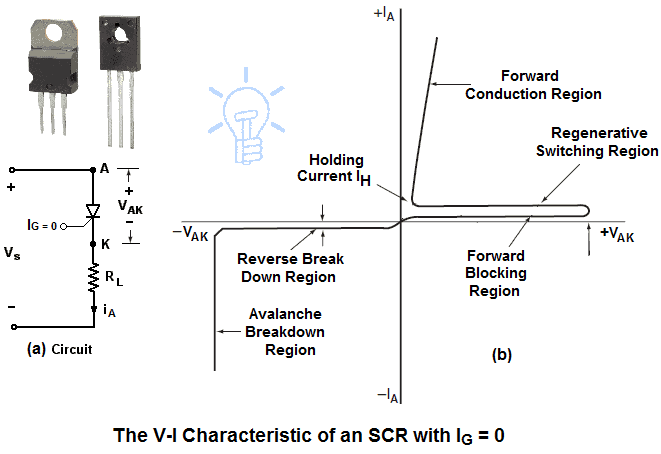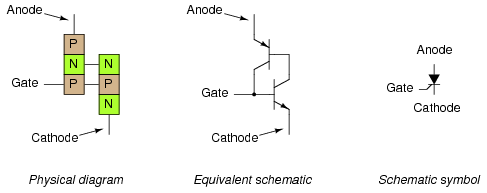SCR and Its Commutation Techniques
SCR is a semiconductor switch which has nearly similar characteristics like a BJT or MOSFET. It is turned on when it gets a pulse in its "Gate". It remains off if the current through it (IAK) falls below a specific value of current named "Holding Current". ONCE A SCR IS ON IT IS ALWAYS ON UNTIL THE GATE CURRENT GOES BELOW "HOLDING CURRENT".

FIGURE: Symbol of a SCR

Figure: I-V Characteristics of SCR
Now, I am going to Discuss some of the Commutation techniques of SCR.
They are:
- Natural Commutation
- Forced Commutation
Natural Commutation:
When a reverse voltage is applied across a SCR's anode and cathode, it gets turned off like a diode. This is the natural Commutation of a SCR.
Figure:Waveform of natural commutation of a SCR
(Image is taken from www.electronicshub.org)
The latching and holding current should be sufficiently low for smoother operation of SCR.
Forced Commutation:
In this method of operation, the on and off condition of SCR is determined by the presence of pulse in its gate. Despite of having a large voltage across its anode and cathode , a SCR can be turned off by manipulating the current at its gate. This mode of operation is useful as the switch ca be turned off anytime according to will without disrupting the voltage applied across it.There are several classes of forced commutation.
Some of them are:
- Class A
- Class B
- Class C
Class A (Load Commutation or Self Commutation):
Here, The SCR was supplying a Load represented as R. When the SCR needs to be switched off, a new circuit is introduced in series which is represented as L and C.
Previously, the SCR was experiencing a constant DC current. As the circuit is introduced, something is changed. An inductor doesn't allow sudden increase in current. As the inductor was experiencing no current before connecting, Its current rises gradually from a very low value to adjust with the DC. As the current increases capacitor gets charged. The R,L and C connection tries to take form of a damped oscillator circuit.
But as the oscillating current tries to go below the holding current, the SCR gets switched off and the load gets disconnected.
In this way, the load is disconnected from the source. But this form of switching is not a very smart approach. Manually introducing a new circuit is not the kind of operation we want to accomplish with a SCR. So later on we will learn several other methods where the switching is controlled by sending a small pulse in the gate of the SCR
Figure: Equivalent circuit
Previously, the SCR was experiencing a constant DC current. As the circuit is introduced, something is changed. An inductor doesn't allow sudden increase in current. As the inductor was experiencing no current before connecting, Its current rises gradually from a very low value to adjust with the DC. As the current increases capacitor gets charged. The R,L and C connection tries to take form of a damped oscillator circuit.
But as the oscillating current tries to go below the holding current, the SCR gets switched off and the load gets disconnected.
In this way, the load is disconnected from the source. But this form of switching is not a very smart approach. Manually introducing a new circuit is not the kind of operation we want to accomplish with a SCR. So later on we will learn several other methods where the switching is controlled by sending a small pulse in the gate of the SCR





Comments
Post a Comment